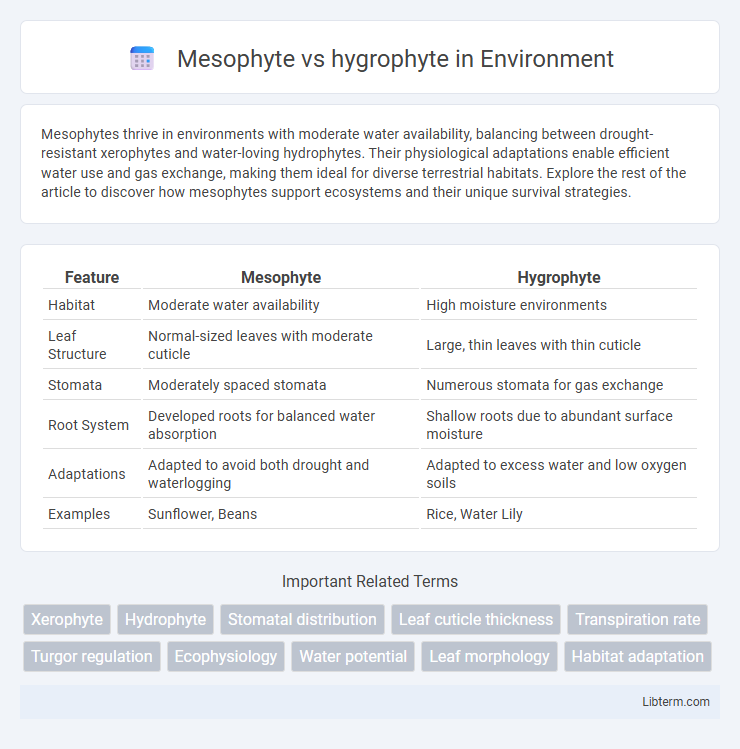Mesophytes thrive in environments with moderate water availability, balancing between drought-resistant xerophytes and water-loving hydrophytes. Their physiological adaptations enable efficient water use and gas exchange, making them ideal for diverse terrestrial habitats. Explore the rest of the article to discover how mesophytes support ecosystems and their unique survival strategies.
Table of Comparison
| Feature | Mesophyte | Hygrophyte |
|---|---|---|
| Habitat | Moderate water availability | High moisture environments |
| Leaf Structure | Normal-sized leaves with moderate cuticle | Large, thin leaves with thin cuticle |
| Stomata | Moderately spaced stomata | Numerous stomata for gas exchange |
| Root System | Developed roots for balanced water absorption | Shallow roots due to abundant surface moisture |
| Adaptations | Adapted to avoid both drought and waterlogging | Adapted to excess water and low oxygen soils |
| Examples | Sunflower, Beans | Rice, Water Lily |
Introduction to Mesophytes and Hygrophytes
Mesophytes are plants adapted to moderate environmental conditions with well-balanced soil moisture, neither too dry nor too wet, making them the most common plant type in temperate regions. Hygrophytes thrive in consistently wet environments such as marshes, swamps, and rainforests, possessing specialized structures for excess water absorption and tolerance. Understanding the ecological adaptations differentiates mesophytes from hygrophytes by their water availability preferences and physiological responses.
Defining Mesophytes: Characteristics and Habitat
Mesophytes are plants adapted to moderate environmental conditions with neither excessive water nor drought, thriving in well-balanced soil moisture. Their characteristics include broad leaves, moderate root systems, and stomatal regulation that balances water retention and gas exchange. Common habitats for mesophytes are temperate forests and grasslands, where rainfall and soil moisture levels suffice for their growth without specialized water storage or drought resistance.
Hygrophytes Explained: Key Features and Environment
Hygrophytes thrive in moist, water-rich environments, such as swamps, marshes, and rainforests, where humidity levels consistently remain high. Their key features include thin cuticles, large stomata for efficient gas exchange, and extensive root systems adapted to absorb abundant water while preventing oxygen deficiency through specialized tissues like aerenchyma. These adaptations contrast with mesophytes, which prefer moderate water availability and have thicker cuticles and smaller stomata to balance water retention and gas exchange.
Morphological Differences Between Mesophytes and Hygrophytes
Mesophytes exhibit thick cuticles and well-developed vascular tissues to minimize water loss, while hygrophytes have thin or absent cuticles and large intercellular spaces in their tissues to facilitate gas exchange in saturated environments. Mesophytes typically possess smaller, thicker leaves with fewer stomata, whereas hygrophytes feature broader, thinner leaves with numerous stomata to enhance transpiration. Root systems in mesophytes are moderately developed for water absorption, contrasting with the shallow, extensive roots of hygrophytes designed for oxygen uptake in waterlogged soils.
Water Requirements and Adaptations
Mesophytes require moderate water availability and have adaptations like well-developed root systems and broad leaves to balance water uptake and loss. Hygrophytes thrive in aquatic or very moist environments, featuring adaptations such as thin cuticles, large stomata, and extensive air spaces in tissues to facilitate water absorption and gas exchange. These water-specific adaptations enable mesophytes to survive in balanced moisture conditions, while hygrophytes are specialized for saturated habitats with constant water presence.
Physiological Responses to Moisture
Mesophytes exhibit moderate physiological responses to moisture, maintaining efficient water uptake and transpiration rates under typical soil moisture conditions, while their stomatal regulation balances water loss and gas exchange. Hygrophytes thrive in high-moisture environments, displaying adaptations such as reduced cuticle thickness and increased stomatal density to facilitate excessive water transpiration and oxygen diffusion in saturated soils. Both plant types modulate root hydraulic conductivity and osmotic potential to optimize water absorption, but hygrophytes show enhanced tolerance to waterlogged conditions compared to mesophytes.
Ecological Roles and Significance
Mesophytes, thriving in moderate environments with balanced water availability, play a crucial role in stabilizing terrestrial ecosystems by supporting diverse plant and animal communities. Hygrophytes, adapted to high-moisture habitats such as wetlands and marshes, contribute significantly to water purification, soil formation, and providing habitat for specialized aquatic and semi-aquatic species. Both plant types enhance biodiversity and ecosystem resilience by occupying distinct ecological niches linked to water availability.
Common Examples of Mesophytes vs Hygrophytes
Common examples of mesophytes include plants such as maize (Zea mays), sunflower (Helianthus annuus), and beans (Phaseolus species), which thrive in moderate water conditions. Hygrophytes typically consist of species like water lilies (Nymphaea), ferns (Pteridophyta), and cattails (Typha), adapted to consistently wet or aquatic environments. These contrasting plant groups highlight adaptations to water availability, with mesophytes favoring balanced hydration and hygrophytes specializing in moist habitats.
Environmental Impact on Distribution
Mesophytes thrive in moderate environments with balanced water availability, while hygrophytes are adapted to consistently wet or aquatic habitats. Environmental factors such as soil moisture, humidity, and precipitation directly influence their geographical distribution, with mesophytes predominating in temperate zones and hygrophytes found mainly in wetlands and rainforests. Changes in climate patterns and water availability due to human activities can shift these habitat boundaries, impacting the ecological balance and distribution of both plant types.
Summary: Choosing the Right Plant for Specific Habitats
Mesophytes thrive in moderate environments with balanced moisture, making them ideal for temperate gardens and agricultural fields. Hygrophytes are adapted to consistently wet or aquatic habitats, such as marshes and swamps, where high humidity and saturated soils prevail. Selecting the right plant depends on understanding water availability and soil conditions to ensure optimal growth and survival in specific habitats.
Mesophyte Infographic

 libterm.com
libterm.com